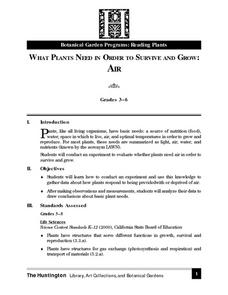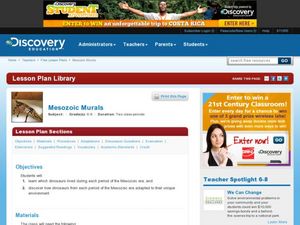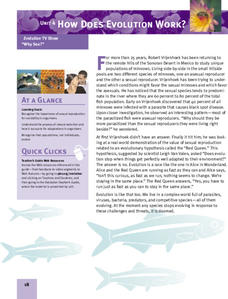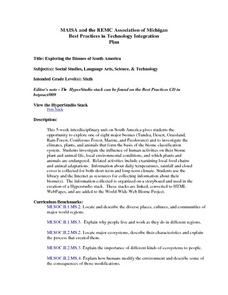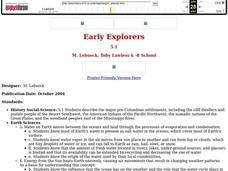Curated OER
What Plants Need in Order to Survive and Grow: Air
Students conduct an experiment to determine whether plants need air in order to survive and grow. They discuss natural resources, analyze slides, and observe and record data from the experiment.
Curated OER
In The Zone
Third graders identify ways that ocean animals grow, survive, reproduce, and adapt. They use computer Internet skills to acces and collect information. They create a PowerPoint presentation. They demonstrate writing skills throughthe...
Curated OER
Making a Mini Worm Habitat
Third graders create an earthworm habitat. In this worms lesson, 3rd graders construct a KWL chart about earthworms and research their habitat. Students create a mini habitat for their earthworms by using gravel, sand, cloth, and soil.
Curated OER
Animal Colors and Shapes
Students investigate the natural characteristics of animals by completing a coloring activity. In this animal properties lesson, students investigate the reasons different animals have specific colors, and how it is essential for...
Curated OER
Mesozoic Murals
Students create a mural of one of the Mesozoic Periods. In this geologic timeline lesson, students will research the plants and animals that lived in the Mesozoic Era in order to create a mural to scale that represents one of the three...
Curated OER
The Cherokee: Trail Where They Cried
Students read the Trail of Tears about the Cherokee Nation removal and write a letter pretending they are the grandparent of a Cherokee child. In this Trail of Tears lesson plan, students understand the changing of boundaries.
Curated OER
Map Your State: Regions of Arizona
Fourth graders define vocabulary and locate physical features on maps. In this mapping lesson, 4th graders explore regions of Arizona through landforms found on topographic maps. Students research the history and culture of...
Curated OER
Geography Booklet
Sixth graders explore geography terms. Students use resources to find real examples of landforms in the world. They create a map showing the landform. students label the surrounding features, countries and states. Students use each...
Curated OER
On the Road with Marco Polo: Marco Polo in China
Students trace Marco Polo's route into China and use the Internet to research major products fabricated in 13th century China. They discuss their findings and write a report on either: silk, porcelain, jade, lacquerware or tea.
Peace Corps
Weather and Water in Ghana
Students investigate the climate of their region. Students research statistics and conduct interviews. Students take a virtual tour of Ghana and discuss its climate. Students consider water conservation and the role it plays in both...
Curated OER
How Does Evolution Work?
Learners are introduced to how the process of evolution works. As a class, they review the characteristics of natural selection and how those with advantageous traits reproduce and survive. To test this theory of natural selection,...
Curated OER
The Greening of Mars: The Changes Necessary to Sustain Life on Mars
Fifth graders discuss the currents conditions on the planet of Mars. In groups, they work together to develop a mechanism that allows for a balanced ecosystem to survive on the planet. After presenting their ideas to the class, they...
Curated OER
Exploring the Biomes of South America
Sixth graders complete a five-week unit investigating the eight major biomes of South America. They conduct Internet research, collect short-term and long-term climate data, and create a HyperStudio slideshow stack about a selected biome...
Curated OER
Forest In A Jar
Tenth graders are introduced to the process of succession and gain awareness of the changing nature of ecosystems. They demonstrate a comprehension of the dynamic nature of ecosystems, including the relationship between ecological...
Curated OER
Three Worm Lesson
Third graders observe properties of three worms. In this living and non-living instructional activity, 3rd graders study characteristics of living and non-living worms. Students experiment to find how light, heat and moisture effects...
Curated OER
American Made
Students view the Film American Made and view the experiences of a Sikh family in the Western part of America. In this life in America lesson, students explore the life of Americans who might by looks be thought to be...
Curated OER
Georgia O'Keeffe "Wake Up and Smell the Roses!"
Learners produce watercolor paintings. For this painter and painting lesson, students view and discuss paintings by Georgia O'Keeffe, understand abstract art and create their own watercolor paintings.
Curated OER
Explore Efficient Energy Uses
In this energy worksheet, learners explore different ways to conserve energy. They write a short description for each of the 10 methods presented.
Curated OER
Early Explorers
Fifth graders study early explorers. In this World history lesson, 5th graders draw an outline of a map labeling each part, build geographical features out of dough, and paint each of the land and water features.
Curated OER
Academic Raceway Ecosystems and Biomes
This ecology PowerPoint allows students to review the characteristics of each biome. There are real photographs to go along with each description of the specific biome. There is a vocabulary slide which also introduces key terms.
Curated OER
Arabian Camel or Dromedary
In this camel worksheet, students study the diagram for an Arabian camel otherwise known as a dromedary. Students read the characteristics of the animal and may click on associated links to learn more.
Curated OER
Social Studies and Children's Literature
Students are read a story about Alejandro and how he builds an oasis to attract animals. Using the text, they discover the needs of the animal not only for water but for safety. They discuss different environmental issues as well as...
Curated OER
Habitats and All That
First graders read books, complete online explorations and discuss the ways in which animals adapt to their habitats in order to survive. They create accordion books, play matching games and dramatize animal adaptations.
Curated OER
Ecosystems: What Are They and How Do They Work?
Students explore the characteristics of major ecosystems, the interactions of the organisms within the systems, and the effects of humans on the system. Both living and non-living components are examined in this five lesson unit.


